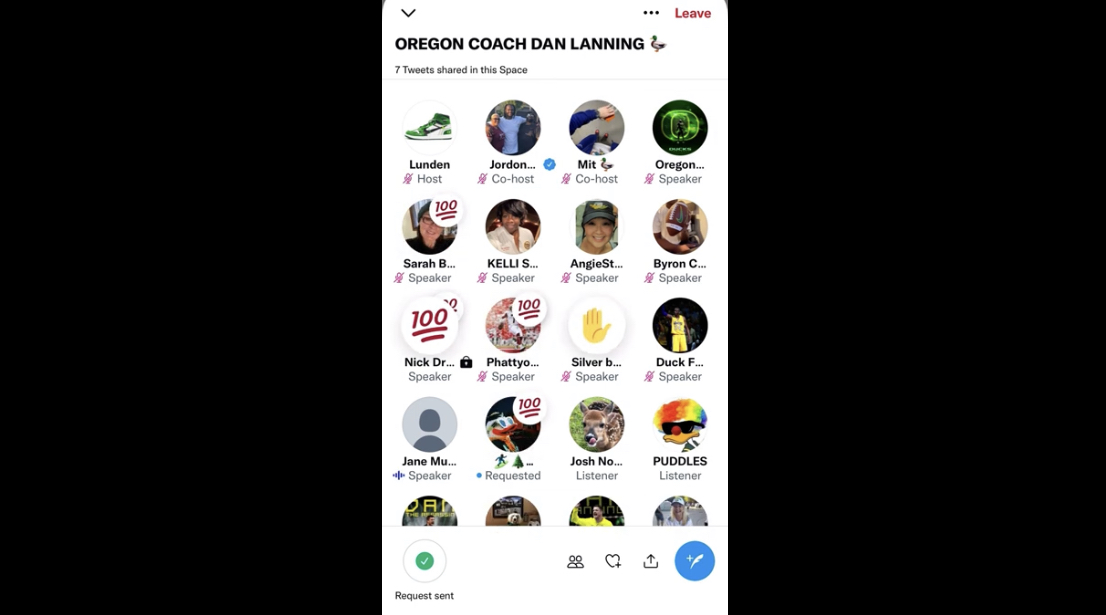The University of Oregon fan base took the “Twitter Spaces” feature to new heights this past weekend, and gave the college football world a preview of an environment in which super fans, current and former players, their family members, and school administrators all bypass media gatekeepers and broadcast rightsholders to hold an open discourse.
In the process of University of Oregon looking to hire a football coach to replace the recently departed Mario Cristobal, the fan-led audio platform commanded a continuous audience of thousands as rumors, reports, leaks, confirmations and conflicts played out in real time.
Aside from the spectacle of Dan Lanning’s brother participating in the Spaces prior to the confirmation of his hiring, you had Oregon Athletic Director Rob Mullens address the community post-hire, program legends and former NFL first round picks Joey Harrington and Akili Smith attempting to explain the leaked letter in which they requested the interview/hiring of Cal Head Coach and Oregon alum Justin Wilcox, and even our very own George Wrighster going head to head with Akili Smith on whether or not Mario Cristobal elevated the state of the program while national college football reporters from around the country looked on:
The novelty and excitement of Oregon’s coaching search becoming a community event set a new standard for how fans, players, and school representatives can participate and collaborate throughout the process. Like with any new technology, there are drawbacks. There was certainly an elevated buzz around the program because of the popularity of this Twitter Spaces event, but there was also a Real Housewives of Eugene-level barrage of drama, conflict, and frustration from the traditionalist swarth of fans whose primary desire is to see program harmony and a unified front, all walking in lockstep to create an attractive façade for potential recruits. For them, the Spaces might have been just a little too real.
For media, the initial reaction to the uniqueness of the Oregon Twitter Spaces had to be that this is a content goldmine. Representatives from Sports Illustrated, 24/7, ESPN, Rivals, On3, as well as many independent blogs and podcasts all either participated, or were live-tweeting notable moments from the event. Some fans even screen recorded some of the more notable moments, such as Athletic Director Rob Mullen’s appearance, and uploaded it to YouTube for posterity:
But the question for established media, as well as for the fan bases that will undoubtedly attempt to springboard off of what the Oregon community did here, and even for the programs themselves, is whether or not Twitter Spaces ultimately proves to be a net positive.
The role of media has traditionally been to play the line cook that provides palatable information for the consuming public with the ingredients served up for them by (or taken unwittingly from) the athletic departments themselves. Over time, schools have learned that with their abundant resources, they can provide these morsels in the most prepackaged and attractive manner for the consumers, often using both technology and former members of the media (that prefer stability to autonomy) to craft narratives that reflect positively upon the program’s efforts. The entire direction of collegiate sports media has been moving in the direction of “polished and pretty,” as well as “top-down control” and the real-time nature of Twitter Spaces is anything but that.
When you have fans that can goad cherished alumni into public spats, or family members of players that can publicly voice frustration with issues of scheme or personality that cause schools to have to publicly address those frustrations, much like with other forms of social media, the level of access may prove to be more of a burden than a boost.
I’m of the opinion that people can be trusted to consume information directly from the source rather than exist on rumors, innuendo, or spin fed by athletic departments to message board operators in exchange for program access. Then again I’m not managing a hundred million dollar business in the era of the transfer portal, whose success and continuity is partially dependent on the massaging of late-teenage egos. “Controlling the message” has never been more important, but in the era of Twitter Spaces, it has never been trickier. A fan with a large following, and a strong opinion on who should or should not start at quarterback, now has the ability to tempt parents and alumni to weigh in on a debate that everyone has access to, potentially in moments of extreme emotion, with the touch of a button.
It’s both an exhilarating and exhausting proposition.
While the Oregon Twitter Spaces of this past weekend was a watershed moment in college football coaching carousel history, its future might prove to bring more volatility than value. Either way, I’ll be listening.


